Riding a gondola through the Venice canals is one of Italy’s most iconic activities. Using a clear rating system, I share my honest review of the experience, along with firsthand tips.
Lists By Lukiih is readers-supported. When you buy with my affiliate link, I may earn a small commission. Thanks!
🍀 Lukiih’s Verdict
I recommend riding a gondola through Venice’s canals if you don’t have a tight budget.
- The canals are a unique experience that’s distinctive to Venice. It’s a delightful ride that can be made extraordinary by a good gondolier.
- It’s a very expensive experience that borders on feeling like a tourist trap.
- Very minimal preparation is required, but I recommend picking a good spot to catch a ride if you want to experience both the narrow canals and the Grand Canal.
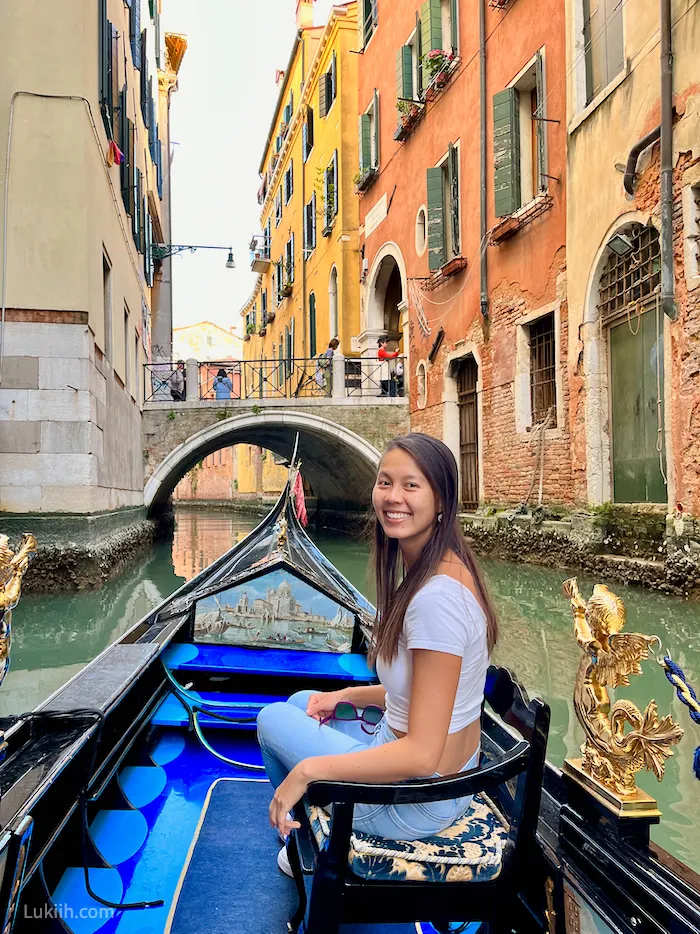
🇮🇹 Planning A Trip to Italy: 12 Practical Things To Know
🏆 Where Does It Rank?
Riding a gondola in Venice ranks as the #7 experience I had in Italy. Here’s how it compares to other things I did on my trip:
🍝 7-10 Days in Northern Italy: 2 Efficient Itineraries
✈️ About My Trip
For context on my review, here’s what to know about my trip:
- I finance my trips and don’t receive sponsorship; this review reflects my honest opinions.
- This post has updated 2024 information, but I rode a Venetian gondola in 2022.
- My Italy trip was in May when it was less crowded and expensive.
- Riding a gondola ride in Venice is a rare experience, as it is the only authentic gondola ride in the world. For centuries, gondolas were a common method of transportation through the Venice canals, making them a historical experience in Italy.
Authentic Venetian gondolas are hand-made and have unique asymmetrical designs. Gondoliers undergo rigorous training, and their licenses are limited and controlled by a guild.
- The experience is very memorable. Floating quietly on the canal, past the colorful buildings of Venice, has a notably different atmosphere compared to just walking around.
- Although no place can replicate Venice’s atmosphere and history, several tourist destinations worldwide offer gondola rides. These include Las Vegas in the United States, Venetian Macao in Macau, and Venetian Village in the UAE.
- The Venetian ride is typically only 30 minutes long. You don’t go far, so whether your experience is memorable heavily depends on your specific route.
See the best places to catch a ride below.
- I found the gondola ride decently fun and delightful. Aside from the serene and beautiful aesthetics, a good gondolier makes the ride informative and entertaining. Waving at different tourists on the canal bridges was also oddly delightful.
- It’s a bit enriching in that this is an authentically historical experience, as you see Venice the same way it was experienced a thousand years ago.
Not all gondoliers sing, so ask if that’s something they do if that’s important to you. Singing costs an additional fee.
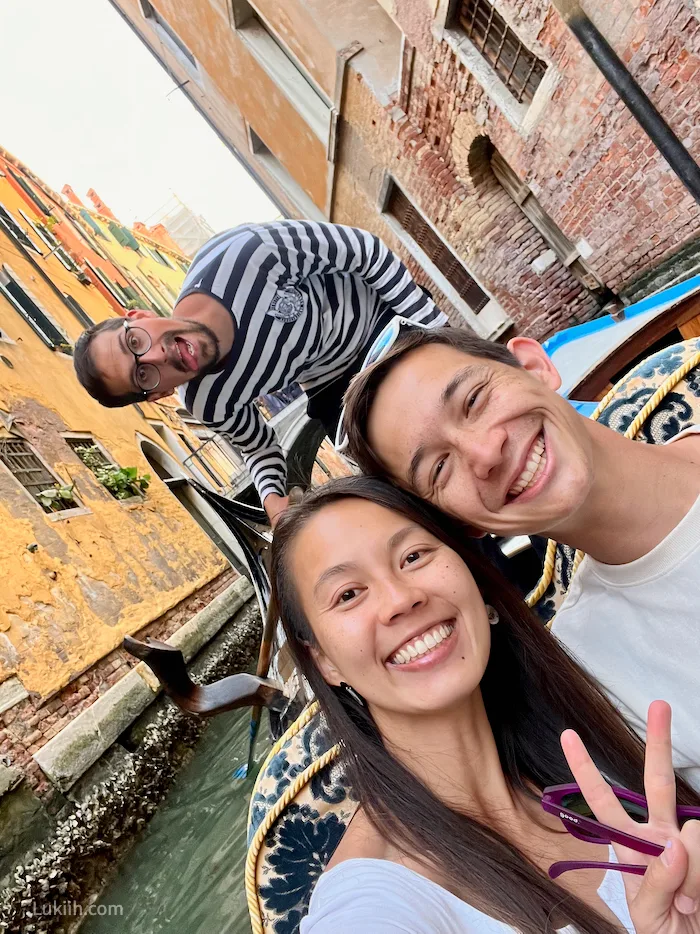
Gondoliers have historically been men, so all but one are women today. Giorgia Boscolo became the first and only female gondolier in 2010. It might be challenging to find her; I tried but failed.
- Venice is a city, and when the tide is low, trash is exposed and smells like sewage.
- Every gondolier is different, so some may not put in much effort to make your experience special.
- It’s not a particularly rewarding experience (i.e., there are no challenges to overcome) because it’s primarily a thing to enjoy.
A standard 30-minute gondola ride in Venice costs €90 (roughly $98 USD). I last checked prices in May 2024. The City of Venice determines the official rates, so the price is non-negotiable. However, certain factors can increase the price.
The cost is fixed and split by the number of passengers. A gondola can hold up to five passengers, not including the gondolier, so if you find other riders, you can pay as little as $20.
Booking a ride online is not necessary, but online reservations are the only way to guarantee splitting the ride with others to save on the costly price.
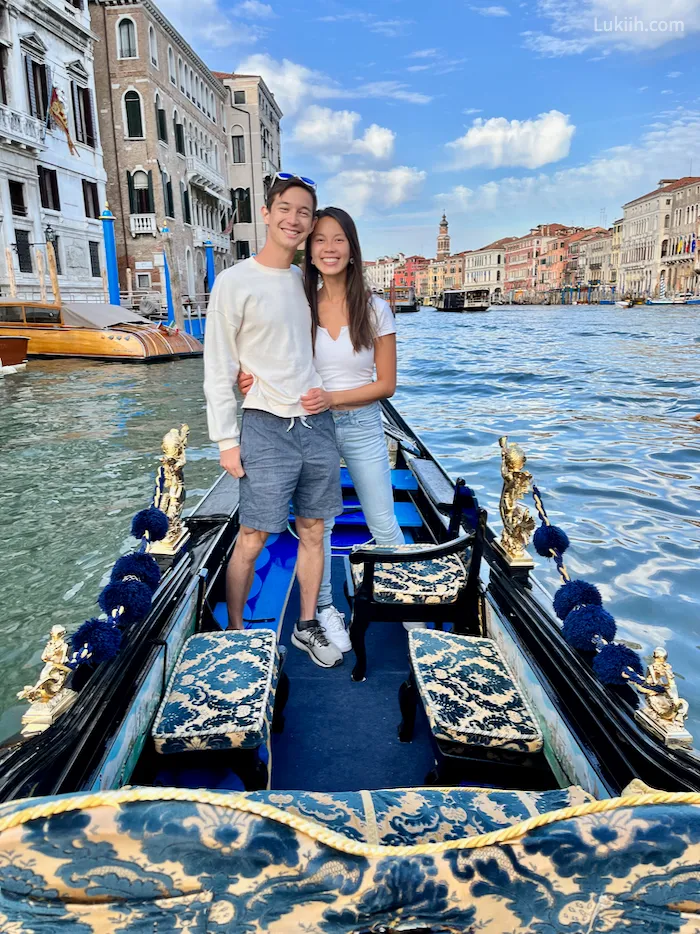
💰 My Italy Trip Cost: Budget Breakdown (2025)
- You don’t need specific skills or fitness to ride a gondola. You’ll need to step onto the gondola and balance briefly, but the gondolier can help you.
- Gondoliers are available in all six of Venice’s districts. Most gondola rides are concentrated around St. Mark’s Square or Rialto Bridge, where the tourists are concentrated. However, if you catch a ride in a tourist hot spot, you may not be able to experience the smaller, serene canals as gondoliers have set routes they can take.
- You can easily catch one when you see a gondolier or gondola station in Venice, so booking a ride online is entirely optional. Online reservations are the only way to guarantee splitting the ride with others to save on the costly price. Bring euros, as gondoliers only accept cash (they do not carry credit card readers).
Scroll down for the best places and best times to catch a ride.
How To Guide & Tips
Interested in riding a gondola in Venice after reading my review? Below is a practical how-to guide and firsthand tips.
When Do Price Increase
Although the price is non-negotiable, there are a few things that can increase or decrease the cost of a gondola ride in Venice:
- 🌅 Timing – A 30-minute ride is the standard €90 price before 7 pm. After 7 pm (around sunset), the price increases to €110.
- ⏰ Ride duration – Before 7pm, you can extend the ride by 20 minutes for an additional €45. After 7 pm, the price increases to €55 for extra time.
- 🎶 Singing – If you want a gondolier to sing, they will charge an additional €20 or more. Not all gondoliers provide this service.
Remember that the total cost is fixed. It will be cheaper if you split the ride with others.
Best Places & Routes
There are two types of Venice canals you can pass through on a gondola:
- The Grand Canal – wide, touristy, and scenic
- Smaller canals – narrow, quiet, and authentic
Gondoliers have a few set routes they can take depending on the starting location. This means that the starting point of your ride determines your route.
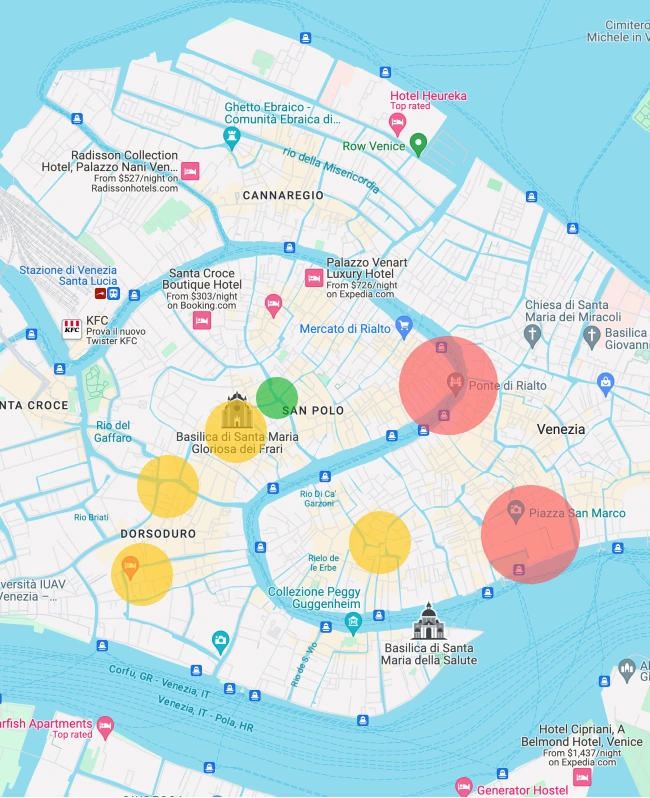
I divide the routes into touristy, serene, and combo, and I think the latter is the best.
- 📍Tourist route – Most rides will be where the tourists are concentrated, around St. Mark’s Square or Rialto Bridge (see red circles on the map).
- Pros: These places are the easiest way to get a ride, as they’re available anytime. You’ll see iconic landmarks like the Doge’s Palace, the Bridge of Sighs, and the Rialto Bridge.
- Cons: These areas are crowded, and there might be a line depending on the time of day. Your route will also be mostly or entirely along the busy Grand Canal, so you won’t experience the authentic, small canals.
- 📍 Serene route – If you don’t want to experience the Grand Canal, you can also catch a ride that only passes through the narrow canals.
Finding a gondolier in these quieter canals will be more challenging as there will be fewer of them, but if you walk around long enough, you will eventually see a gondola station.
- 📍 Combo route – I recommend catching a ride from a location where you can experience the smaller canals for 20 minutes and the busy Grand Canal for 10 minutes. The yellow circles on the map above are potential places to get a route that combines both. The green circle on the map is where I caught my ride.
Best Times
Gondola rides are available daily from morning to night, typically from 9 am to 9 pm.
- 👍 Best times – To avoid crowds, the best times to catch a ride are in the early morning (before 9 am) and nighttime (after 9 pm). Sunset time (6:30 to 7 pm) is also great for beautiful lighting and stunning photos.
- 👍 Worst times – Late mornings and early afternoons (11 am to 3 pm) are usually the most crowded, so those will be the most hectic times to ride one.
If you’re in Venice during the summer, bring sunblock or shade, as most of the ride is exposed.
Italy Trip Planner 2024
To make your travel preparation easier, download the trip planner below. It has destination-specific travel information, itinerary, map, and packing list.
My trip planners are built on Notion, which I use for all my travel planning. I genuinely love this tool and creating an account is free.
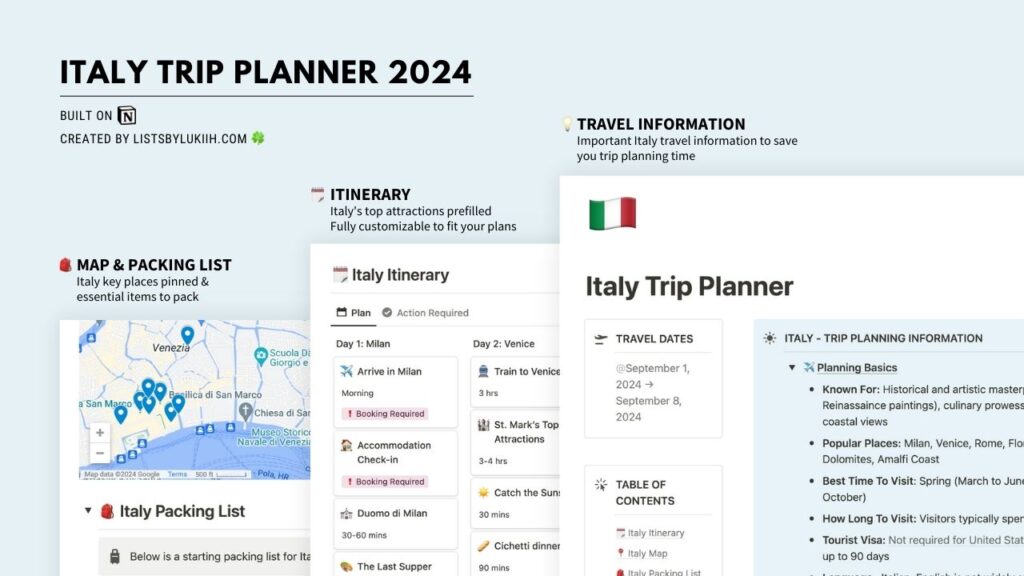
Italy Travel Guides
- 🇮🇹 Planning A Trip to Italy: 12 Practical Things To Know
- 🍝 7-10 Days in Northern Italy: 2 Efficient Itineraries
- 💰 My Italy Trip Cost: Budget Breakdown (2025)
- 🎭 Venice Day Trip: 8 Great Things To Do + 1-Day Itinerary
- 👨🎨 3 Amazing Days in Florence: Itinerary With Hidden Gems
- ⛰️ Hiking Cinque Terre: My Honest Review & Tips
- 🌷 Lake Como Day Trip: My Honest Review & Tips
- 🚣♂️ Gondola Ride in Venice: My Honest Review & Tips
- 🧀 Parma Day Trip (Italy): My Honest Review & Tips
